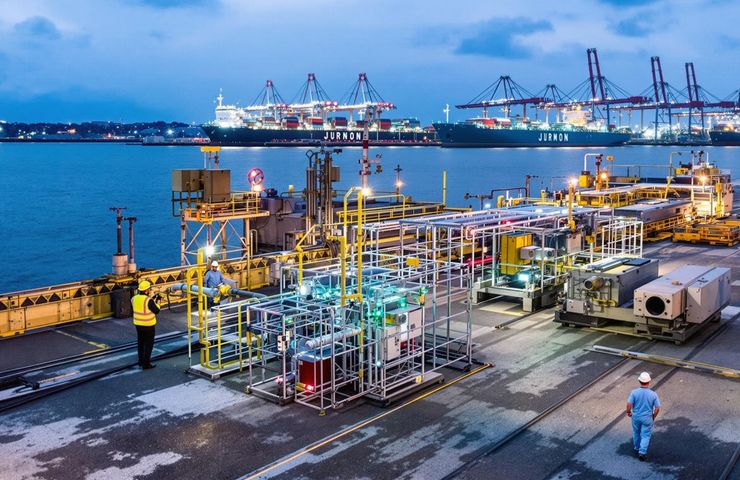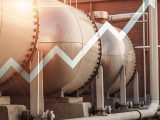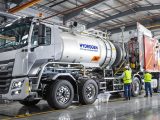
Ammonia Fuel Cell: Second-Gen Ammonia Cracker-Integrated SOFC Demo at Jurong Port
August 5, 2025Picture waking up to Singapore’s skyline at sunrise, spotting container ships gliding in like ghosts—totally silent and fueled by something that doesn’t kick out a trace of carbon. That’s the magic of ammonia-to-hydrogen tech, and on August 4, 2025, Jurong Port got a firsthand demo. Researchers from the Energy Research Institute @ NTU (ERI@N) cranked up their second-gen ammonia cracker–linked Solid Oxide Fuel Cell (SOFC) prototype right at the quayside. It’s basically an ammonia fuel cell rig powered by hydrogen carrier ammonia, and for a place where maritime trade is in the DNA, this demo was a loudspeaker for clean maritime energy and a bright green arrow toward maritime decarbonization.
Could Ammonia Be the Game-Changer for Clean Maritime Energy?
We’ve tried just about everything to pull carbon out of shipping—biofuels, LNG, battery-hybrid setups—but ammonia is stealing the show. Since its molecule lacks carbon, it becomes a super-dense, easy-to-move hydrogen carrier ammonia that slots right into current storage and transport systems. And this isn’t just another lab demo; Jurong Port’s field trial proves that an ammonia fuel cell approach—where ammonia cracking pairs with solid oxide fuel cell stacks—can actually handle the real-world power demands of ships and docks. That puts us exactly where we need to be for the IMO’s 2050 climate targets.
How This Ammonia Cracker–SOFC Duo Delivers Power
- Ammonia Cracker Module: Think of it as a mini high-temperature oven—ammonia (NH₃) heats up to about 600–800°C over a fancy nickel or ruthenium catalyst, popping it open into hydrogen (H₂) and nitrogen (N₂). Fresh catalyst designs and snappy reactor shapes have slashed cracking time and cut heat loss by nearly 30% versus older lab setups.
- Solid Oxide Fuel Cell (SOFC) Stacks: These ceramic-powered stacks run at 700–900°C, shuttling oxide ions from one electrode to the other. When hydrogen reacts, you get electricity, water and heat. They’re tough, fuel-flexible workhorses—perfect for handling that clean hydrogen the cracker spits out.
- Heat Integration: What would normally be wasted as hot exhaust is captured, redirected, and put back into the system, pushing overall efficiency north of 50%—and hitting nearly 60% if we just count electrical output.
- Compact Design: Thanks to clever engineering, the second-gen prototype shrank its footprint by about 30% and slashed startup time in half—an absolute must on cramped ship decks or busy quays where every inch and every second count.
- Power Output: In its demo at Jurong Port, the unit churned out a continuous 2.3 kW of clean electricity—enough juice for ship auxiliaries, crane drives, dock lighting, or even keeping radar and comms systems online without a hiccup.
Key Players Making It Happen
This field trial wouldn’t exist without a trio of heavy hitters coming together:
- Energy Research Institute @ NTU (ERI@N): The brains out of Nanyang Technological University, designing, building and tweaking the integrated cracker–SOFC system, then running it through its paces onsite.
- Jurong Port: Singapore’s flagship multi-purpose port, opening its docks, ammonia-handling network and safety protocols for this on-deck experiment.
- Surbana Jurong: The global urban and infrastructure consultancy that handled permits, logistics and ensured everything met Singapore’s strict safety and environmental playbook.
Singapore’s been cultivating an energy R&D ecosystem for decades—covering solar, wind, hydrogen and now ammonia. That foundation of government grants, skilled talent and industry ties paved the way for ERI@N’s cracker–SOFC demo. It’s stepping off earlier lab tests and small pilots into a full-scale, real-world trial that could finally unlock commercialization.
“Seeing the ammonia cracker team up with SOFC stacks outside the lab tells us loud and clear that this combo works in the real world,” said an ERI@N spokesperson. “We’re thrilled Jurong Port gave us the green light for this groundbreaking trial,” added a port operations manager. “It underscores our drive for green innovation and cements our spot as a regional leader in sustainable logistics.”
Why It’s a Game-Changer for Maritime Decarbonization
Decarbonizing shipping is no niche hobby—it’s a global must-do. Here’s why getting ammonia fuel cell systems right could shake things up:
- Hitting Climate Goals: IMO’s roadmap calls for shipping emissions to plummet by at least 50% from 2008 levels by 2050. Swapping diesel for ammonia-based power could be the lever we need.
- Economic Stability: Unlike pure hydrogen, ammonia is already a staple in global trade—mostly for fertilizer—so the supply chain and pricing are well-established.
- Cleaner Air: Ports are notorious for diesel exhaust—NOₓ, SOₓ and particulates. Replacing old generators with ammonia fuel cell systems slashes those pollutants, making coastal air healthier.
- Fresh Industries: Scaling up ammonia-to-hydrogen tech and solid oxide fuel cell production opens doors for new sectors—catalyst design, fuel cell manufacturing and specialized maritime engineering services.
Beyond emissions cuts, clean ports can lure more shipping lines keen to green their supply chains. That edge helps Singapore keep its crown in global logistics.
Looking Ahead: Charting the Course to Scale
Of course, no tech journey is a straight shot. We still need to boost cracking efficiency, iron out energy losses and train crews to handle ammonia safely. On top of that, policy frameworks have to catch up—recognizing ammonia fuel cell setups in emission regs and offering incentives to early-adopter shipping lines. ERI@N’s already chatting with government agencies to secure funding for bigger demos and start lining up commercial partners.
- Rolling out larger-scale trials on tugboats and offshore support vessels;
- Setting up more dockside demos at major hubs—think Tuas Terminal and beyond;
- Partnering with shipyards to build new vessels with integrated cracker–SOFC modules from day one;
- Working with regulators to nail down safety standards and carbon-accounting rules for ammonia-powered systems.
With the right policy nudge—think R&D grants, green-ship financing and carbon pricing—this tech could surge forward. This isn’t just a drop in the ocean; it’s a tidal wave of progress ready to reshape how we power the world’s fleets and ports.
Seeing this demo up close really drove home that tackling climate change demands big collaborations—researchers, port crews and engineers all pitching in to turn bold ideas into real solutions. Now that ammonia cracker–SOFC setups are stepping off the test bench, I’m excited to watch this wave of innovation roll out across the seas.



 With over 15 years of reporting hydrogen news, we are your premier source for the latest updates and insights in hydrogen and renewable energy.
With over 15 years of reporting hydrogen news, we are your premier source for the latest updates and insights in hydrogen and renewable energy.